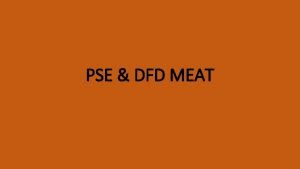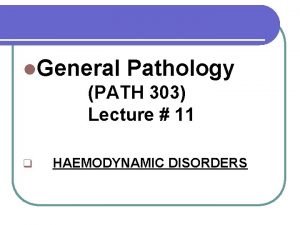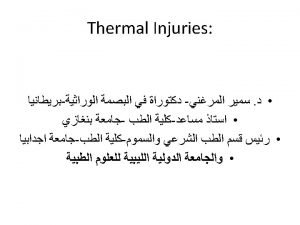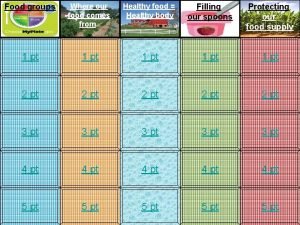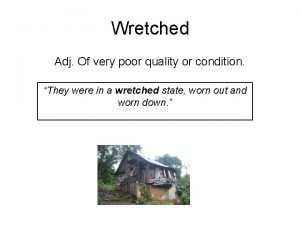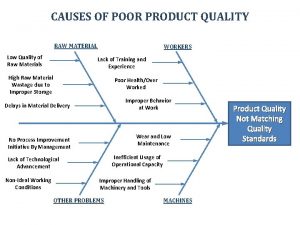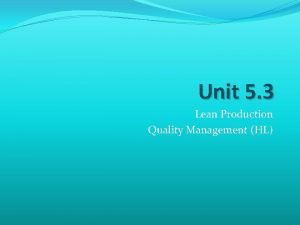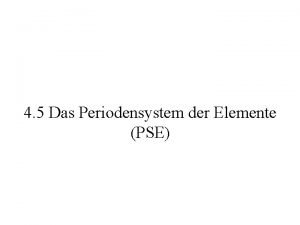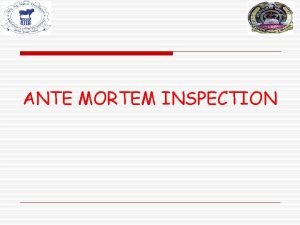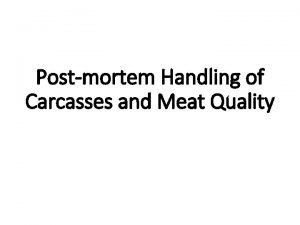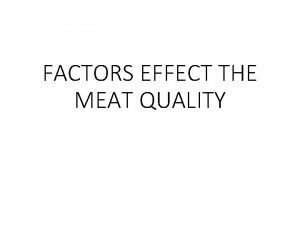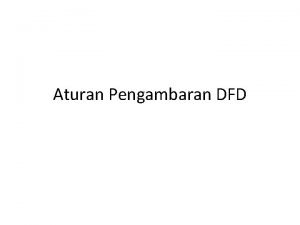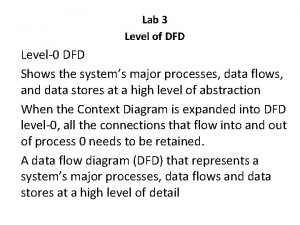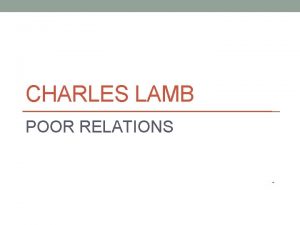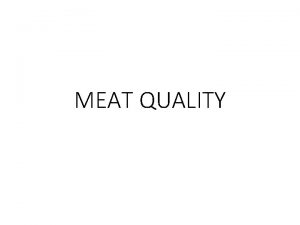PSE DFD MEAT Lean Meat Quality Poor antemortem
















- Slides: 16

PSE & DFD MEAT

Lean Meat Quality • Poor ante-mortem handling can produce PSE or DFD meat and may influence eating quality. • PSE affects pigs and DFD occurs in all species. • PSE-like characteristics, particularly pale color, have been reported in some turkey and chicken meat recently.

The names describe the characteristics of the muscle in comparison with normal meat. Pale Soft Exudative Dark Firm Dry

They are defined by the p. H value of the meat PSE 45 min post mortem of <6 DFD after 12– 48 hours post mortem of > 6 Dark cutters

• The color of meat is one of the most important criteria consumers use to select meat. • Meat which is too pale or too dark is discriminated against in preference to normal colored meat

• The large amount of exudate (drip loss or purge) from PSE meat, especially if it collects in the packaging, also contributes to the undesirable appearance.

Low p. H and high temperature causes denaturation of some of the muscle proteins leading to a reduction in the amount of water they bind. Shrinkage of the myofibrillar components expels the resultant fluid into the extracellular space The large amount of exudate reflects a poorer waterholding capacity. When the muscle is cut the extra fluid exudes to produce the exudate

The high p. H results in relatively little denaturation of the proteins, water is tightly bound and little or no exudate is formed.

Light scattering from the meat surface is probably caused by differences in the refractive indices of the sarcoplasm and myofibrils. The shrinkage of the myofilament lattice increases the amount of light reflected from the meat. No shrinkage cause translucent structure that absorbs rather than reflects light

• PSE meat reduced yield both of fresh meat and of processed products like hams and bacon • DFD meat has poor processing characteristics with slow or uneven formation of cured meat pigments. • Flavour development is poor in processed products and flavour is poor in cooked fresh DFD meat • PSE pork tends to taste dry and have poor texture after cooking

Glycogen depletion ante mortem characterized by very low levels of carbohydrates in the muscle. The low levels of carbohydrates present in the meat restrict the growth of lactic acidproducing bacteria This encourages the growth of bacteria that metabolize amino acids and proteins These produce unpleasant smelling waste products. The high p. H value of the meat promotes this bacterial growth.

Causes of PSE and DFD meat • Both PSE and DFD meat are caused by stress experienced live animal at and before slaughter.

PSE • The problem is greater in stress-susceptible genotypes. • Poultry and pigs carry one or two copies of the Malignant Hypothermia (Halothane) gene. • Antemortem stress (short term stress) usually increases the severity of PSE. • Muscle p. H drops very fast, body temp increases causing the meat to be pale in color, soft in texture with exudation of water.

DFD Chronic stress that can produce DFD meat; Ølong periods without food (fasting) Øfatigue caused by very long transport under poor conditions Øfighting that occurs when mixed together

• Caused by a shortage of glycogen at slaughter. • Without enough glycogen to convert to lactic acid, the muscle p. H stays high, closer to 7. 0 (living muscle p. H) • Results in muscle too dark in color, firm in texture, and dry on muscle surface

 Difference between dfd and pse meat
Difference between dfd and pse meat Postmortem clot
Postmortem clot Postmortem trauma
Postmortem trauma Difference between antemortem clot and postmortem clot
Difference between antemortem clot and postmortem clot Lichtenberg figur
Lichtenberg figur Dfd level 0
Dfd level 0 Lean meat sample
Lean meat sample Wretched verb
Wretched verb Poor material
Poor material Lean production and quality management
Lean production and quality management Six sigma qfd
Six sigma qfd Spaghetti meat market form
Spaghetti meat market form 5. hauptgruppe periodensystem
5. hauptgruppe periodensystem Pse
Pse Pcpkey
Pcpkey Triangle pse is similar to triangle tsv
Triangle pse is similar to triangle tsv Sudrail pse
Sudrail pse
